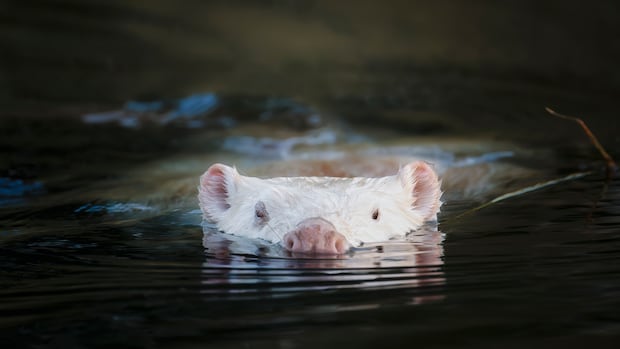OttawaOttawa wildlife photographers have captured stunning images of a rare leucistic beaver.The leucistic rodent has been spied on several occasions near Perth, Ont. CBC News · Posted: Oct 08, 2025 4:00 AM EDT | Last Updated: October 8Rare white beaver spotted in marsh near Perth An expert on Canadian mammals says the beaver has leucism — a genetic condition that causes a loss of pigmentation. Leucistic beavers are so rare the Canadian Museum of Nature has a pelt in its collection that’s more than a century old.On a river near Perth, Ont., a boatload of wildlife photographers silently stalked their quarry on a recent fall evening.With an electric trolling motor providing propulsion, the water remained millpond-flat as they glided upstream. But then a splash rang out like a shot as their target’s tail slapped the water and the creature dove beneath the surface. The mythical white beaver had smelled them.Ottawa photographer Dennis Jackson had never expected to see such a rare creature, despite a lifetime spent capturing images of wildlife.After spotting the white beaver on a boat trip with his neighbour a few weeks back, Jackson was eager to return to the river with pre-eminent Canadian naturalist Michael Runtz, his wife Britta Runtz, who is also a professional photographer, and a CBC reporter.Beyond hoping for another sighting, Jackson wanted to answer a question: Was this beaver an albino — which would be an unlikely survival story given that most albino animals are nearly blind — or leucistic, a genetic condition that causes a partial loss of pigmentation?The white beaver had appeared again at dusk, but after smelling the humans it was not clear if it would stick around to answer the question. Ottawa photographer Dennis Jackson, left, and naturalist Michael Runtz were delighted to photograph a rare white beaver on a recent boat trip near Perth, Ont. (Stu Mills/CBC)As the photographers waited with bated breath, the white beaver glided past the boat underwater, its pale-coloured tail flashing, before surfacing in a patch of reeds. The creature then climbed on land to preen its coat, revealing a patch of dark fur on its front left paw, and eyes which were clearly dark. “With true albinism, you can’t produce any dark pigmentation, so the eyes are always pink, so I would say that’s a leucistic beaver,” Runtz concluded.The recently retired Carleton University professor was delighted by the sighting. “To see a totally white beaver with dark eyes and a dark foot, that’s incredible!”Even better, they had the photographs to prove it. “I’m very happy just seeing it, if I didn’t get any photographs I’d be almost equally as happy. But I must admit I am a little happier that we were successful in getting pictures, too,” Runtz said.Like other wild creatures, beavers occasionally produce offspring with colour mutations, but lighter coats can make them more visible to predators.The dark eyes and a dark patch of fur on its paw suggests this is a leucistic rather than albino beaver. (Dennis Jackson)White beavers are unusual enough that the Canadian Museum of Nature holds in its collection a leucistic beaver pelt that was collected in Rainy River, Ont., 1918. Dominique Fauteux, a research scientist at the museum and a specialist in mammalogy, says the rarity of white beavers suggests that in evolutionary terms it has not been a beneficial mutation. “Over millions of years that kind of mutation, that genetic mutation, hasn’t become very common,” he told CBC. “The pressure for evolution is not very strong to keep that gene in the gene pool.”For Jackson, the scientific impact of the sighting was less important than its uniqueness.”That is totally one of the coolest things that I’ve seen,” he declared as he steered the boat toward home.With files from Stu Mills
Thursday, 27 Nov 2025
Canada – The Illusion
Search
Have an existing account?
Sign In
© 2022 Foxiz News Network. Ruby Design Company. All Rights Reserved.
You May also Like
- More News:
- history
- Standing Bear Network
- John Gonzalez
- ᐊᔭᐦᑊ ayahp — It happened
- Creation
- Beneath the Water
- Olympic gold medal
- Jim Thorpe
- type O blood
- the bringer of life
- Raven
- Wás’agi
- NoiseCat
- 'Sugarcane'
- The rivers still sing
- ᑲᓂᐸᐏᐟ ᒪᐢᑿ
- ᐅᑳᐤ okâw — We remember
- ᐊᓂᓈᐯᐃᐧᐣ aninâpêwin — Truth
- This is what it means to be human.
- Nokoma












